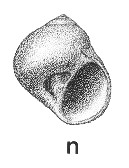
Revised descriptions of New Zealand Cenozoic Mollusca from Beu and Maxwell (1990)

 | Revised descriptions of New Zealand Cenozoic Mollusca from Beu and Maxwell (1990) | 
|
  (Pl. 41n): GS5311, W21/f8518, base of Maraetotara Sand, Cape Kidnappers, Hawke's Bay, early Castlecliffian (GNS) |
Beu & Maxwell (1990): Chapter 15; p. 321; pl. 41 n.
Synonymy: Natica planisuturalis Marwick 1924d, p. 550; Natica haweraensis Marwick 1924d, p. 551
Classification: Naticidae: Naticinae
Description: Small for family (10-16 mm high, a few specimens to 20 mm), with moderately low to tall spire; suture inconspicuous, tangential, so spire outline almost straight, or in some specimens slightly concave below suture. Last whorl very large, rounded, enveloping most of earlier whorls, with smoothly rounded base and simple, D-shaped aperture. Outer lip slightly retracted to suture at top. Inner lip thickened over parietal area but thin below, fused with large, smooth, subcircular funicle that fills central third to half of large, circular umbilicus; funicle separated from last whorl by wide groove, varying in width from half width of funicle to equal in width to funicle. Surface smooth and polished apart from a few faint growth lines. Protoconch small, very low, of 1.6 smooth, weakly inflated whorls, with a minute apex.
Comparison: The last appearance of Taniella planisuturalis has commonly been used in the past as an index of the end of Nukumaruan time, although a few undoubted early Castlecliffian specimens are known in central and southern North Island, and the species is among several (e.g., Area cottoni, Trivia zelandica) that remained common at Ohope Beach, Bay of Plenty, during mid-Castlecliffian time, after they became extinct in Wanganui Basin. Differences regarded by Marwick (1924d) as distinguishing T. haweraensis from T. planisuturalis (principally a difference in funicle diameter) are now seen to intergrade, and these names were regarded a synoyms by Beu & Maxwell (1990) and Beu (2009). T. planisuturalis is larger and has a taller spire, straighter spire outlines, and a smaller funicle than earlier species of Taniella.
Distribution: Opoitian-Castlecliffian. Okauawa Stream, Kereru Road, central Hawke's Bay, late Nukumaruan (type of Natica planisuturalis); Waihi Beach, Hawera, South Taranaki, Waipipian (type of N. haweraensis). Widespread but uncommon in Pliocene to Nukumaruan rocks throughout New Zealand; rare in early Castlecliffian rocks at Wanganui and at Cape Kidnappers (Maraetotara Sand); common at several localities in mid-Castlecliffian sandstone and mudstone at Ohope Beach, Whakatane (B.A. Marshall collection, NMNZ); almost always in shallow-water sandstone or sandy coquina limestone.
Cite this publication as: "A.G. Beu and J.I. Raine (2009). Revised
descriptions of New Zealand Cenozoic Mollusca from Beu and Maxwell (1990). GNS
Science miscellaneous series no. 27."
© GNS Science, 2009
ISBN
978-0-478-19705-1
ISSN 1177-2441
(Included with a PDF facsimile file
copy of New Zealand Geological Survey Paleontological Bulletin 58 in CD version
from: Publications Officer, GNS Science, P.O. Box 30368 Lower Hutt, New
Zealand)